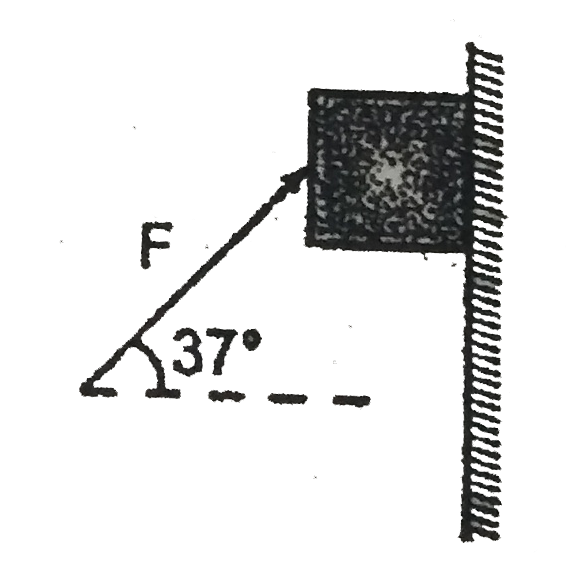A 70.0 kg astronaut pushes to the left on a spacecraft with a force →F in "gravity-free" space. The spacecraft has a total mass of 1.0×104 kg. During the push, the astronaut accelerates to the right with an acceleration of 0.36 m/s2.
Determine the magnitude of the acceleration of the spacecraft.
51.4 m/s2
0.36 m/s2
2.5×10−3 m/s2
7.0×10−3 m/s2
The correct Answer is:C
To solve the problem, we will use Newton's third law of motion, which states that for every action, there is an equal and opposite reaction. Here’s how we can determine the magnitude of the acceleration of the spacecraft step by step:
Step 1: Identify the forces acting on the astronaut and the spacecraft.
- The astronaut pushes the spacecraft to the left with a force F.
- Due to this push, the astronaut experiences an equal and opposite force −F that accelerates him to the right.
Step 2: Calculate the force exerted by the astronaut.
- The astronaut has a mass ma=70.0kg and accelerates to the right with an acceleration aa=0.36m/s2.
- Using Newton's second law, the force exerted by the astronaut can be calculated as:
F=ma⋅aa=70.0kg⋅0.36m/s2=25.2N
Step 3: Apply Newton's third law to find the acceleration of the spacecraft.
- According to Newton's third law, the force exerted by the astronaut on the spacecraft is equal in magnitude but opposite in direction to the force exerted by the spacecraft on the astronaut. Therefore, the force acting on the spacecraft is also 25.2N to the left.
- The mass of the spacecraft is ms=1.0×104kg.
Step 4: Calculate the acceleration of the spacecraft.
- Using Newton's second law for the spacecraft:
as=Fms=25.2N1.0×104kg=2.52×10−3m/s2
Conclusion:
- The magnitude of the acceleration of the spacecraft is 2.52×10−3m/s2 to the left.
- The astronaut pushes the spacecraft to the left with a force F.
- Due to this push, the astronaut experiences an equal and opposite force −F that accelerates him to the right.
- The astronaut has a mass ma=70.0kg and accelerates to the right with an acceleration aa=0.36m/s2.
- Using Newton's second law, the force exerted by the astronaut can be calculated as:
F=ma⋅aa=70.0kg⋅0.36m/s2=25.2N
- According to Newton's third law, the force exerted by the astronaut on the spacecraft is equal in magnitude but opposite in direction to the force exerted by the spacecraft on the astronaut. Therefore, the force acting on the spacecraft is also 25.2N to the left.
- The mass of the spacecraft is ms=1.0×104kg.
- Using Newton's second law for the spacecraft:
as=Fms=25.2N1.0×104kg=2.52×10−3m/s2
- The magnitude of the acceleration of the spacecraft is 2.52×10−3m/s2 to the left.
Topper's Solved these Questions
- FORCE AND MOTION - I BOOK - RESNICK AND HALLIDAYCHAPTER - FORCE AND MOTION - I EXERCISE - PRACTICE QUESTIONS (Matrix-Match)
7 Videos
- FORCE AND MOTION - I BOOK - RESNICK AND HALLIDAYCHAPTER - FORCE AND MOTION - I EXERCISE - PRACTICE QUESTIONS (Integer Type)
3 Videos
- FORCE AND MOTION - I BOOK - RESNICK AND HALLIDAYCHAPTER - FORCE AND MOTION - I EXERCISE - PRACTICE QUESTIONS (More than One Correct Choice Type)
5 Videos
- FLUIDSBOOK - RESNICK AND HALLIDAYCHAPTER - FLUIDSEXERCISE - PRACTICE QUESTIONS (Integer Type )
5 Videos
- FORCE AND MOTION-IIBOOK - RESNICK AND HALLIDAYCHAPTER - FORCE AND MOTION-IIEXERCISE - PRACTICE QUESTIONS (Integer Type)
1 Videos
Similar Questions
Knowledge Check
A 70.0 kg astronaut pushes to the left on a spacecraft with a force →F in "gravity-free" space. The spacecraft has a total mass of 1.0×104 kg. During the push, the astronaut accelerates to the right with an acceleration of 0.36 m/s2.
Which one of the following statements concerning this situation is true ?AThe spacecraft does not move, but the astronaut moves to the right with a constant speed.BThe astronaut stops moving after he stops pushing on the spacecraft.CThe force exerted on the astronaut is larger than the force exerted on the spacecraft.DThe velocity of the astronaut increases while he is pushing on the spacecraft.A force creates acceleration of 10m/s2 in a body of 0.5 kg. the value of force will be:
A6NB5NC20ND50NThe force needed to produce an acceleration of 6m/s2 in a ball of mass 4 kg will be
A24NB30NC32ND36N
An unloaded truck weighing 2000kg has a maximum acceleration of 0.4m/s2. What is the maximum acceleration, when it carries a load of 2000kg?
View SolutionA planet has a mass of 2.4×1026 kg with a diameter of 3×108 m. What will be the acceleration due to gravity on that planet ?
View SolutionThe earth's gravitational force causes an acceleration of 5m/s2 in 1 kg mass somewhere in space. How much will the acceleration of a 3 kg mass be at the same place?
View SolutionA proton has a mass of 1.673×10−27kg. If the proton is accelerated to a speed of 0.93c , what is the magnitude of the relativistic momentum of the proton?
View SolutionA 1 kg block is being pushed against a wall by a force F=75N as shown in the figure. The coefficient of friction is 0.25. The magnitude of acceleration of the block is:

View Solution
